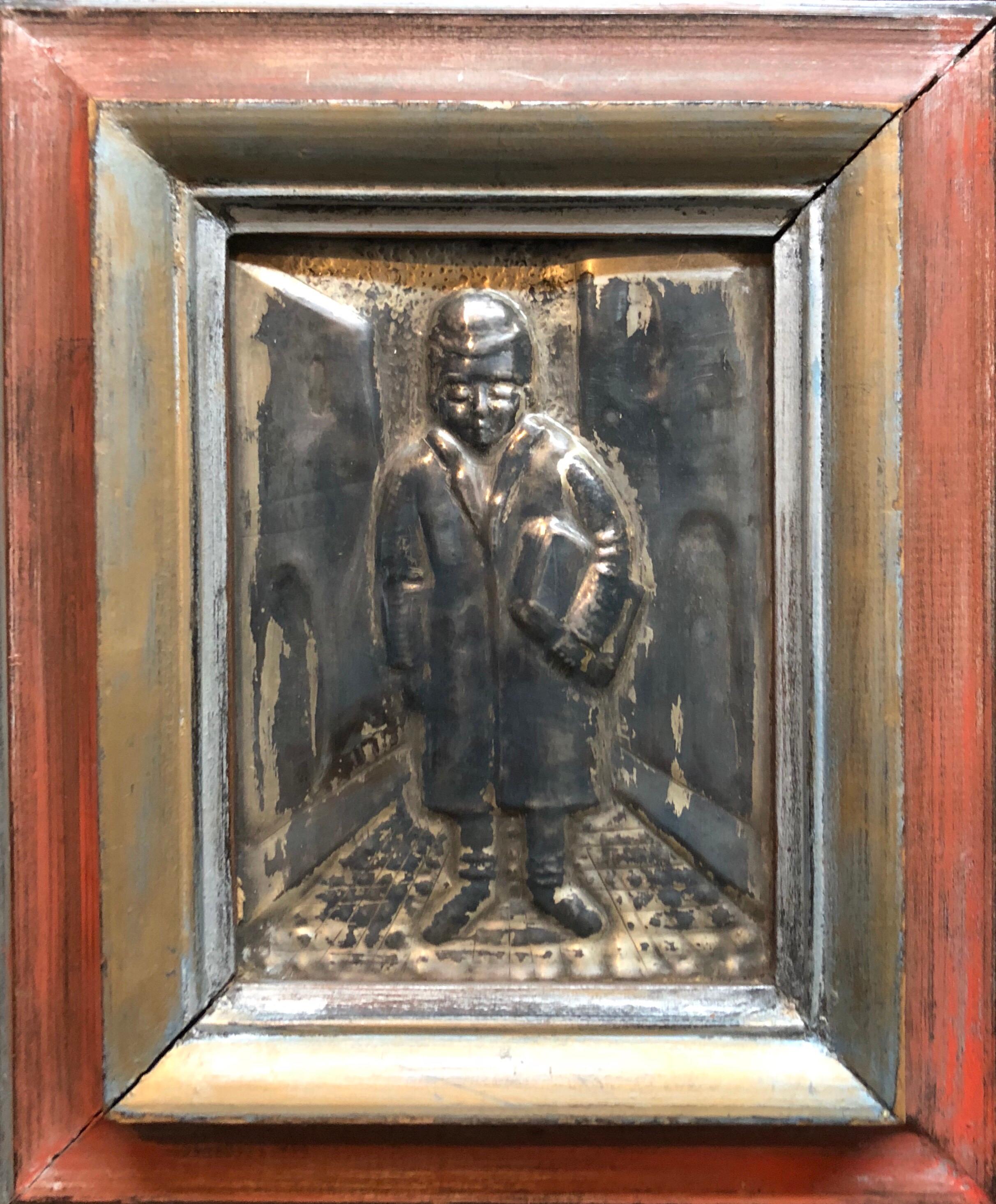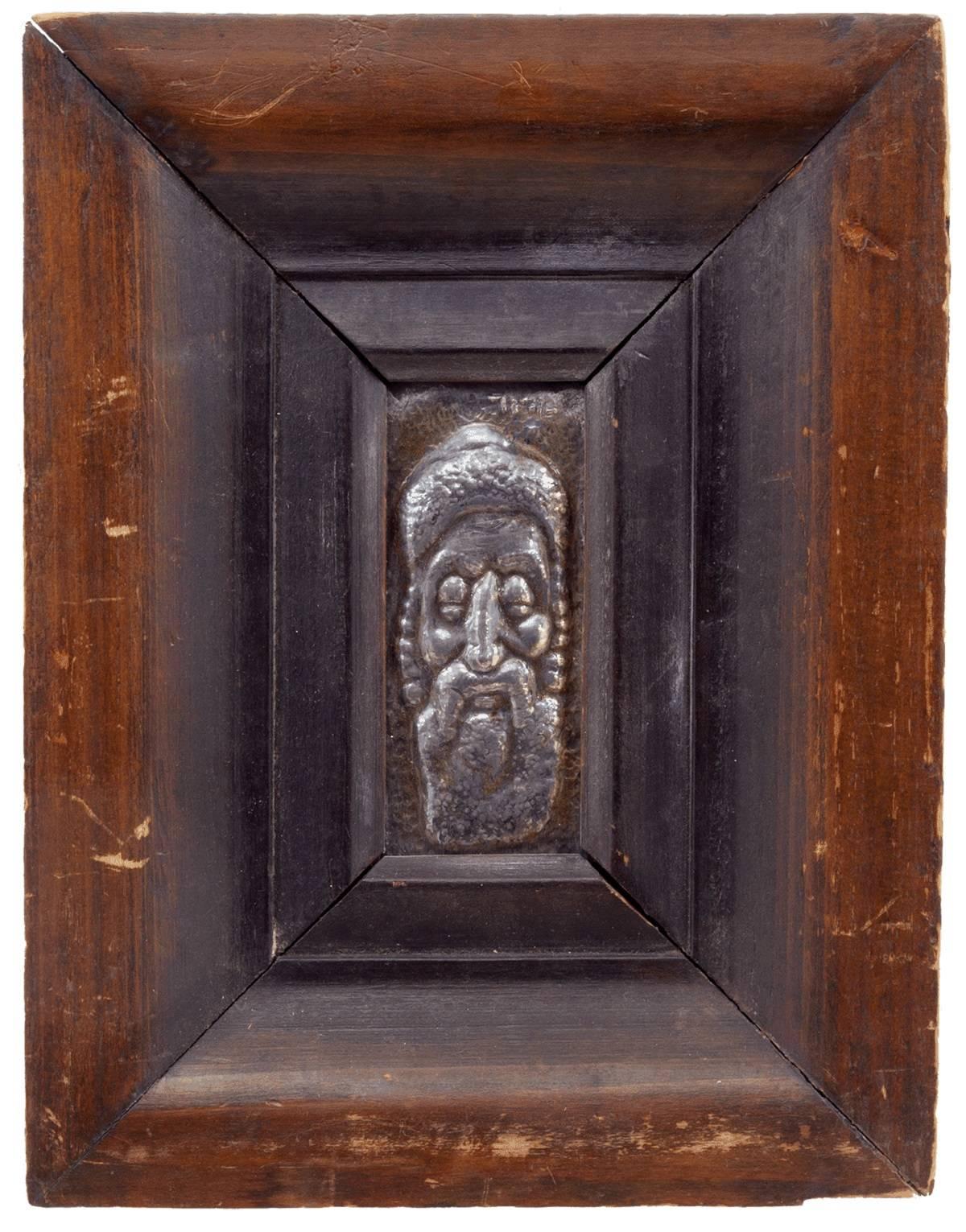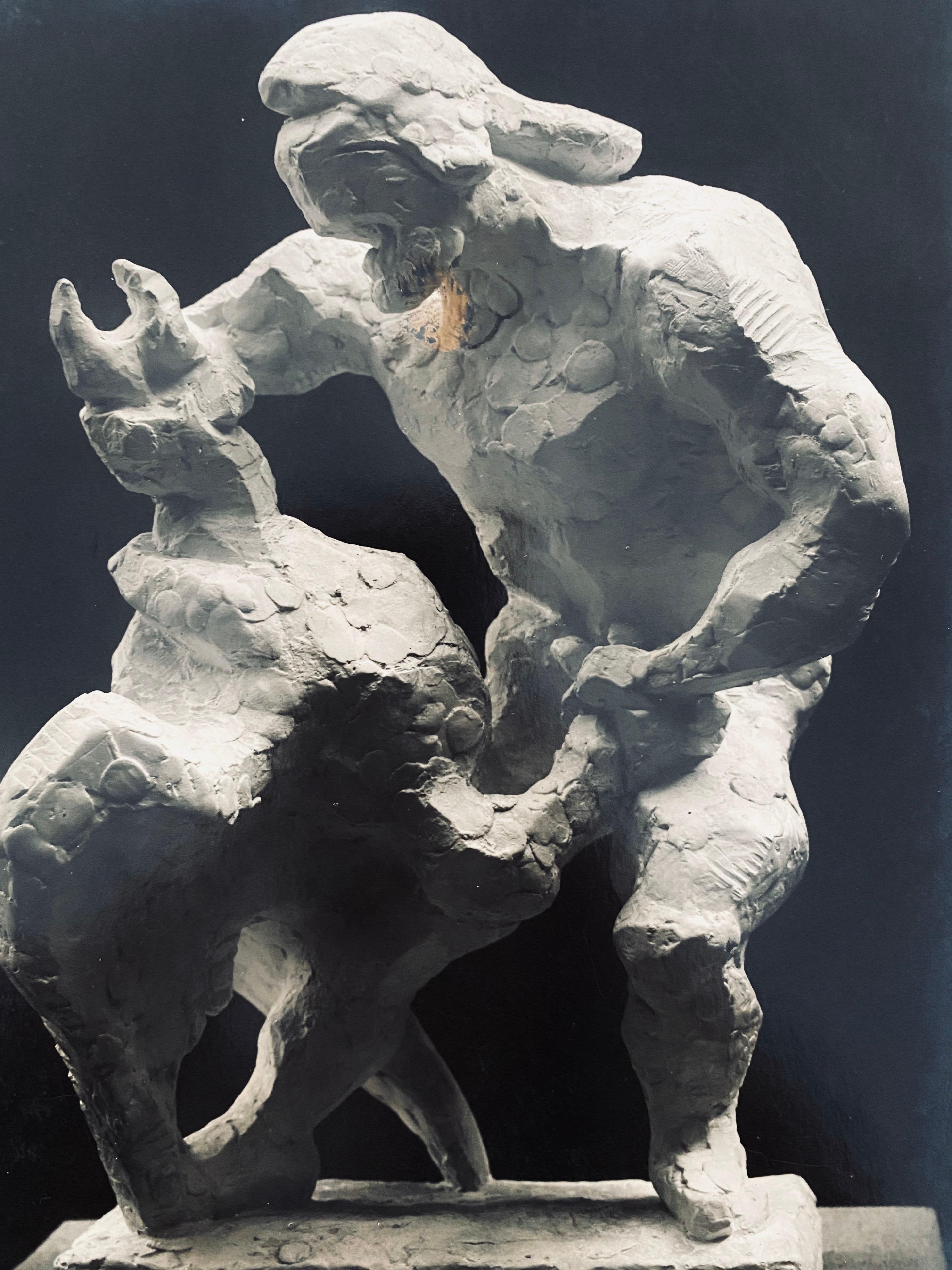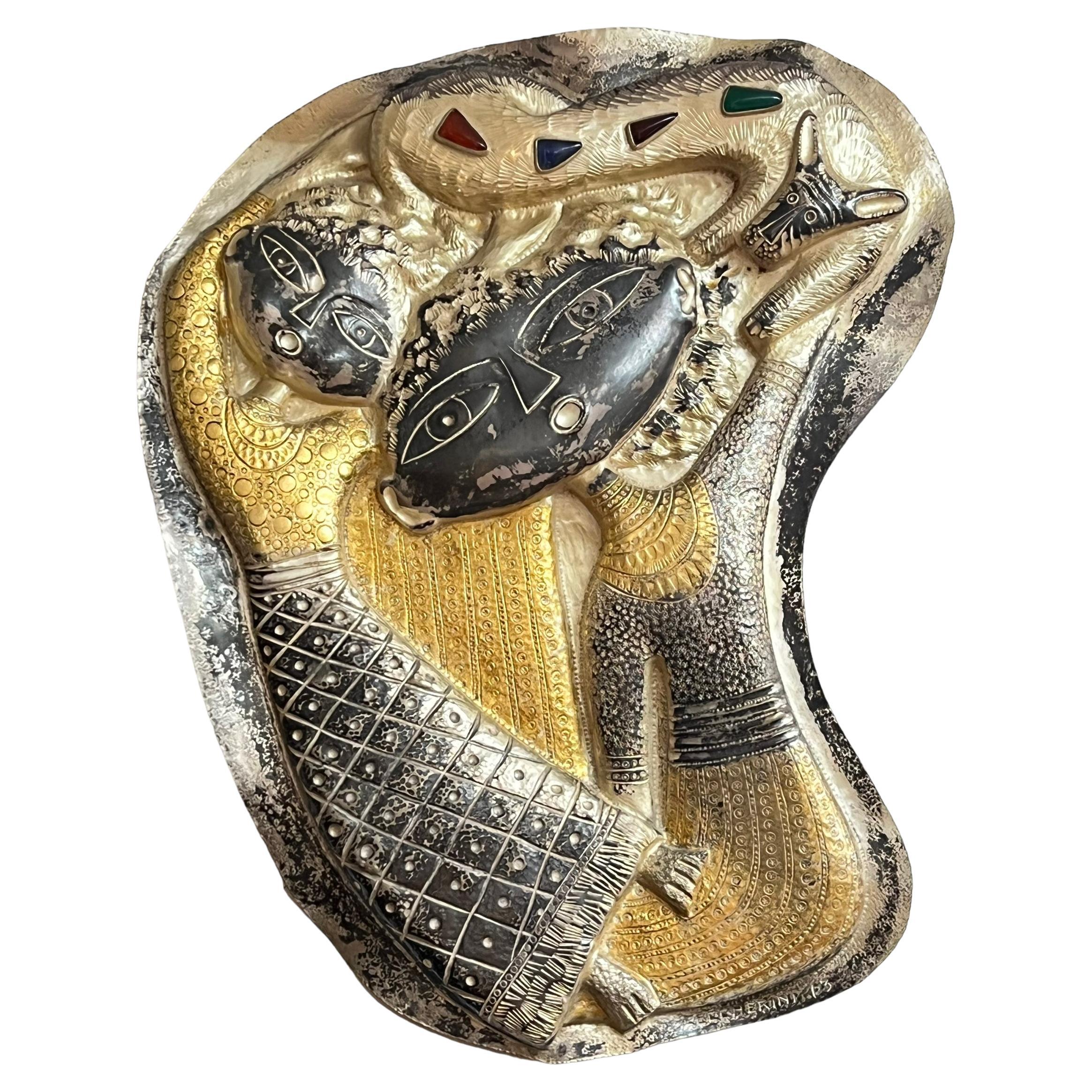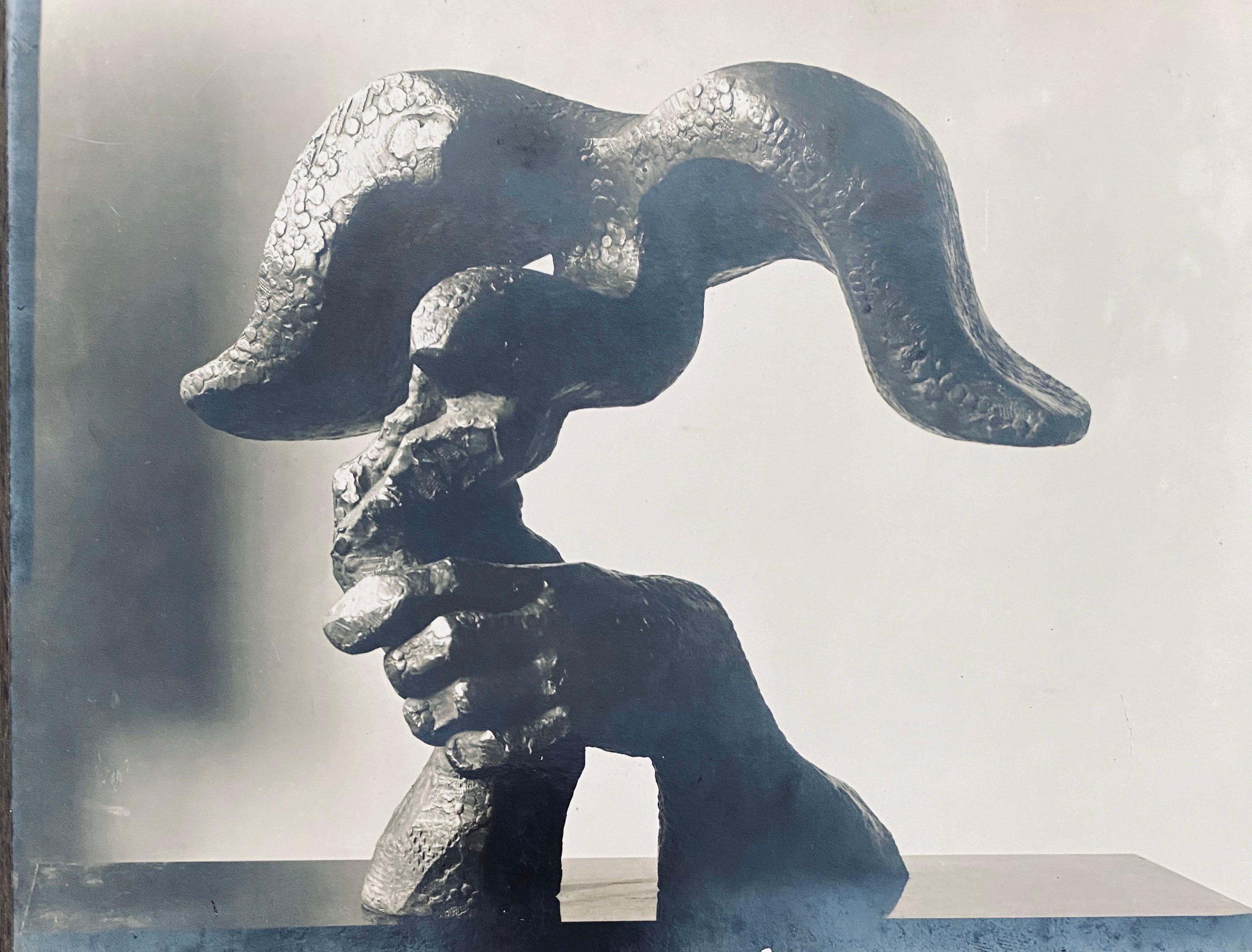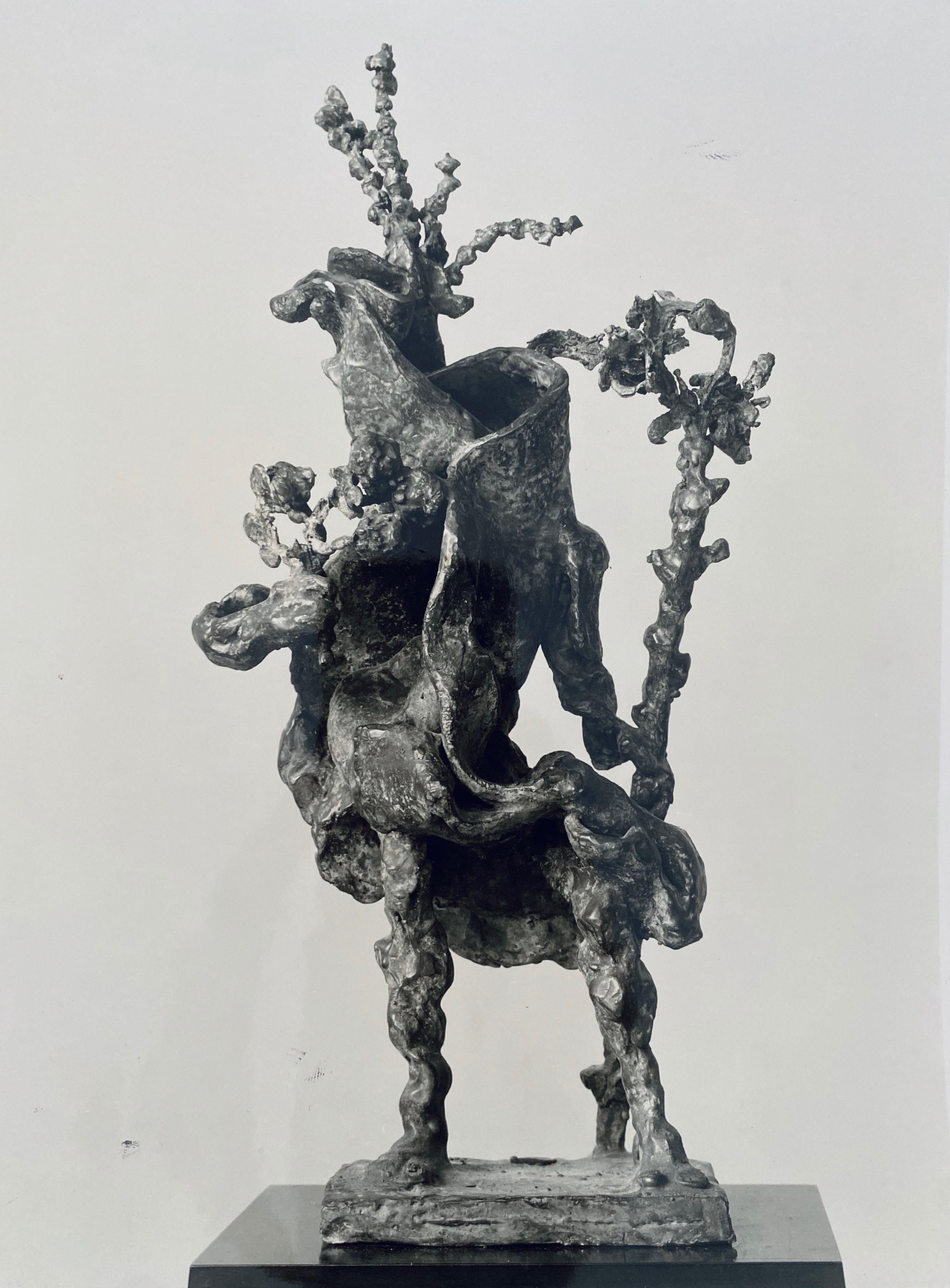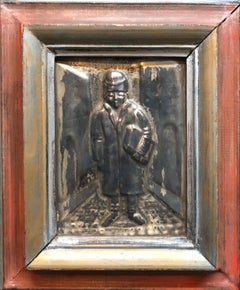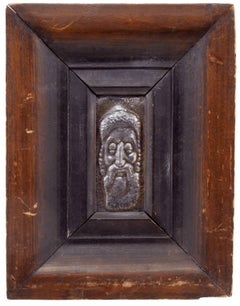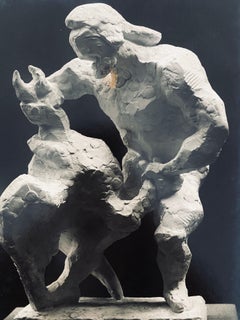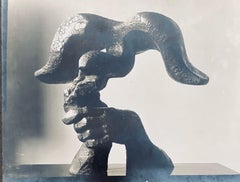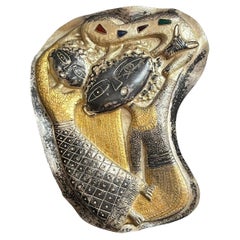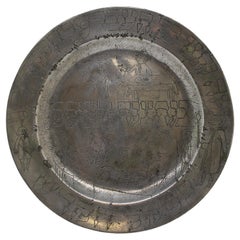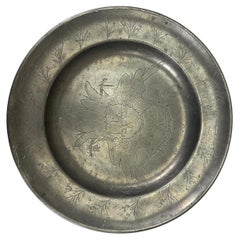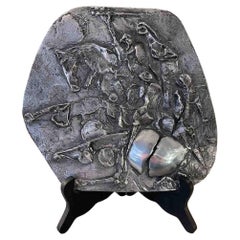Items Similar to The Struggle, Rare Sterling Silver Israeli Judaica Cubist Sculpture Plate Plaque
Want more images or videos?
Request additional images or videos from the seller
1 of 6
Jacques LipchitzThe Struggle, Rare Sterling Silver Israeli Judaica Cubist Sculpture Plate Plaquec.1970s
c.1970s
$1,200
£890.45
€1,037.25
CA$1,670.41
A$1,860.15
CHF 968.11
MX$22,935.43
NOK 12,329.57
SEK 11,588.60
DKK 7,739.16
Shipping
Retrieving quote...The 1stDibs Promise:
Authenticity Guarantee,
Money-Back Guarantee,
24-Hour Cancellation
About the Item
Sculptor Jacques Lipchitz Terling Silver Anniversary Silver Sculpture Plate Israel
This is a beautiful sterling silver commemorative plate. It was specially made for the Silver Anniversary of Israel. It was designed by the famous artist Jacques Lipchitz. The plate shows a struggle between "Israel" (man holding menorah) and an Angel. The plate measures 11 3/4" around and weighs 29.4 ozt. This plate is sterling silver mounted on a bronze base. The back of the plate has all the numbers and signature of the artist. This plate is also displayed in the Museum of Israel. The original fitted box is also included.
Jacques Lipchitz (1891-1973) was a Cubist sculptor, from late 1914. Lipchitz retained highly figurative and legible components in his work leading up to 1915–16, after which naturalist and descriptive elements were muted, dominated by a synthetic style of Crystal Cubism. In 1920 Lipchitz held his first solo exhibition, at Léon Rosenberg's Galerie L'Effort Moderne in Paris. Fleeing the Nazis he came to the US and settled in New York City and eventually Hastings-on-Hudson.
Jacques Lipchitz was born Chaim Jacob Lipschitz, in a Litvak family, son of a building contractor in Druskininkai, Lithuania, then within the Russian Empire. At first, under the influence of his father, he studied engineering, but soon after, supported by his mother he moved to Paris (1909) to study at the École des Beaux-Arts and the Académie Julian.
It was there, in the artistic communities of Montmartre and Montparnasse, that he joined a group of artists that included Juan Gris and Pablo Picasso as well as where his friend, Amedeo Modigliani, painted Jacques and Berthe Lipchitz.
Living in this environment, Lipchitz soon began to create Cubist sculpture. In 1912 he exhibited at the Salon de la Société Nationale des Beaux-Arts and the Salon d'Automne with his first solo show held at Léonce Rosenberg's Galerie L'Effort Moderne in Paris in 1920. In 1922 he was commissioned by the Barnes Foundation in Merion, Pennsylvania to execute five bas-reliefs.
With artistic innovation at its height, in the 1920s he experimented with abstract forms he called transparent sculptures. Later he developed a more dynamic style, which he applied with telling effect to bronze compositions of figures and animals.
With artistic innovation at its height, in the 1920s he experimented with abstract forms he called transparent sculptures. Later he developed a more dynamic style, which he applied with telling effect to bronze figure and animal compositions.
With the German occupation of France during World War II, and the deportation of Jews to the Nazi death camps, Jacques Lipchitz had to flee France. With the assistance of the American journalist Varian Fry in Marseille, he escaped the Nazi regime and went to the United States. There, he eventually settled in Hastings-on-Hudson, New York. In 1954 a Lipchitz retrospective traveled from The Museum of Modern Art in New York to the Walker Art Center in Minneapolis and The Cleveland Museum of Art. In 1959, his series of small bronzes "To the Limit of the Possible" was shown at Fine Arts Associates in New York. Lipchitz taught one of the most famous contemporary artists, Marcel Mouly.
Beginning in 1963 he returned to Europe where he worked for several months of each year in Pietrasanta, Italy. In 1972 his autobiography was published on the occasion of an exhibition of his sculpture at The Metropolitan Museum of Art in New York.
He had studied at the Ecole des Beaux Arts in Paris from 1909 to 1911 and at the Academy Julian. He arrived in America when the Abstract Expressionist movement was beginning to take hold, and this likely influenced the much more emotional expression of the later part of his career. His work was much more emotional and rounded in form than the earlier cubist work, and is subject matter was epic, reflecting his interest in myths, heroic tales and religious symbolism. La Ruche, the artists' complex south of Montparnasse that Lipchitz knew well during his first years in Paris. He was a denizen of La Ruche which provided refuge for Jewish emigres like Chaim Soutine, Amedeo Modigliani and Marc Chagall, who shared with Lipchitz an irrepressible expressionist impulse. The balance between unbridled Eastern expressiveness and French clarity helps characterize Lipchitz's successful Parisian work. Jacques Lipchitz died in Capri, Italy. His body was flown to Jerusalem for burial.
- Creator:Jacques Lipchitz (1891-1973, French)
- Creation Year:c.1970s
- Dimensions:Height: 1 in (2.54 cm)Diameter: 11.75 in (29.85 cm)
- Medium:
- Movement & Style:
- Period:
- Condition:minor scratching and wear to surface. see photos.
- Gallery Location:Surfside, FL
- Reference Number:1stDibs: LU38210959132
Jacques Lipchitz
Biography: Jacques Lipchitz was a celebrated Lithuanian-born French sculptor best known for his Cubist works depicting figures, portraits, and still lifes made of bronze or stone. Born Chaim Jacob Lipchitz on August 22, 1891 in Druskinikai, Lithuania to a Litvak (Lithuanian Jewish) family. To please his parents, Lipchitz studied engineering as a young man. But around 1909, he decided to pursue art instead and moved to Paris to study at the Ecole des Beaux Arts and the Académie Julian in Paris. Lipichitz was a part of the artistic milieu in the famed Montmarte neighborhood of Paris, which included Pablo Picasso, Amedeo Modigliani, and Juan Gris. He became especially influenced with work by Pablo Picasso, who had pioneered a style of art called Cubism. Cubism was an art movement in which images were fractured and broken into simultaneous fragmented shards of perspective. It was strongly geometric and not based on traditional representational art like portraits or landscapes. At the beginning of his career, Lipchitz created figural sculptures, but by around 1913 he'd shifted direction toward Cubism. At the time, most Cubist artists were painters, but Lipchitz had met Russian sculptor Alexander Archipenko, who was experimenting with Cubist sculpture. However he always retained recognizable figural elements in his work.
When faced with the Nazi occupation, he fled to the United States during World War II. Lipchitz went on to have a retrospective exhibition in 1954 which travelled from The Museum of Modern Art in New York to the Walker Art Center in Minneapolis, and finally to the Cleveland Museum of Art. Today, his works are in the collections of the Art Institute of Chicago, The Metropolitan Museum of Art in New York, the Tate Gallery in London, the Los Angeles County Museum of Art, and the National Gallery of Art in Washington, D.C., among others. Lipchitz died on May 16, 1973 in Capri, Italy.
About the Seller
4.9
Platinum Seller
Premium sellers with a 4.7+ rating and 24-hour response times
Established in 1995
1stDibs seller since 2014
1,777 sales on 1stDibs
Typical response time: 1 hour
- ShippingRetrieving quote...Shipping from: Surfside, FL
- Return Policy
Authenticity Guarantee
In the unlikely event there’s an issue with an item’s authenticity, contact us within 1 year for a full refund. DetailsMoney-Back Guarantee
If your item is not as described, is damaged in transit, or does not arrive, contact us within 7 days for a full refund. Details24-Hour Cancellation
You have a 24-hour grace period in which to reconsider your purchase, with no questions asked.Vetted Professional Sellers
Our world-class sellers must adhere to strict standards for service and quality, maintaining the integrity of our listings.Price-Match Guarantee
If you find that a seller listed the same item for a lower price elsewhere, we’ll match it.Trusted Global Delivery
Our best-in-class carrier network provides specialized shipping options worldwide, including custom delivery.More From This Seller
View AllJudaica Silvered Copper Repousse Sculpture Relief Plaque Shtetl Yeshiva Bochur
By Arieh Merzer
Located in Surfside, FL
Arieh Merzer was a prominent Israeli artist and metal worker.
Arie Merzer, an artist who worked in hand-hammered copper, was born in Warsaw, Poland in 1905, the scion of a large Has...
Category
Mid-20th Century Figurative Sculptures
Materials
Metal
Jerusalem Rabbi, Repousse Sculpture Relief Plaque Israeli Judaica
By Arieh Merzer
Located in Surfside, FL
Arieh Merzer was a prominent Israeli artist and metal worker.
Arie Merzer, an artist who worked in hand-hammered copper, was born in Warsaw, Poland in 1905, the scion of a large Has...
Category
20th Century Modern Figurative Sculptures
Materials
Metal
Vintage Silver Gelatin Photograph Jacques Lipchitz Sculpture Photo Signed
By Marc Vaux
Located in Surfside, FL
Marc Vaux, a figure of Montparnasse, produced a trove of photographs which are currently held in the collection of the Centre Pompidou in Paris, France. Marc Vaux was committed equally to supporting artists, notably by creating the Foyer des Artistes (1946-70) and, in 1951, the first Musée du Montparnasse at 10, rue de l’Arrivée.
Marc Vaux was born on February 19, 1895 in Crulai, Normandy Thanks to the color merchant from whom he bought his plates and his photographic equipment, he met the sculptor Charles Desvergnes winner of Prix the Rome and author of various memorials who was looking for someone to photographs his works. Two of Marc Vaux’s first clients were his neighbors of 21 Avenue du Maine- Marie Vassilieff and Maria Blanchard...
Category
1930s Modern Abstract Photography
Materials
Photographic Paper, Silver Gelatin
Vintage Silver Gelatin Photograph Jacques Lipchitz Bronze Sculpture Photo Signed
By Marc Vaux
Located in Surfside, FL
Marc Vaux, a figure of Montparnasse, produced a trove of photographs which are currently held in the collection of the Centre Pompidou in Paris, France. Marc Vaux was committed equally to supporting artists, notably by creating the Foyer des Artistes (1946-70) and, in 1951, the first Musée du Montparnasse at 10, rue de l’Arrivée.
Marc Vaux was born on February 19, 1895 in Crulai, Normandy Thanks to the color merchant from whom he bought his plates and his photographic equipment, he met the sculptor Charles Desvergnes winner of Prix the Rome and author of various memorials who was looking for someone to photographs his works. Two of Marc Vaux’s first clients were his neighbors of 21 Avenue du Maine- Marie Vassilieff and Maria Blanchard...
Category
1930s Modern Abstract Photography
Materials
Photographic Paper, Silver Gelatin
Vintage Silver Gelatin Photograph Jacques Lipchitz Bronze Sculpture Photo Signed
By Adolph Studly
Located in Surfside, FL
Adolph Studly, Swiss born American photographer. His work is kept in the Photographic Archive at The Museum of Modern Art Archives, New York. He was known for his gallery photograp...
Category
1950s Modern Abstract Photography
Materials
Photographic Paper, Silver Gelatin
Vintage Silver Gelatin Photograph Jacques Lipchitz Bronze Sculpture Photo Signed
By Adolph Studly
Located in Surfside, FL
Adolph Studly, Swiss born American photographer. His work is kept in the Photographic Archive at The Museum of Modern Art Archives, New York. He was known for his gallery photograp...
Category
1940s Modern Abstract Photography
Materials
Photographic Paper, Silver Gelatin
You May Also Like
Patinated Silver Figural Plaque by Roberto Ceccherini from 1963
Located in New York, NY
Our silver plaque by the Italian artist, Roberto Ceccherini, shows children playing with a dog. It is partially gilt and patinated, and decorated with geometric shaped colored glass ...
Category
Mid-20th Century Italian Mid-Century Modern Wall-mounted Sculptures
Materials
Silver
An 18th Century European Purim Pewter Plate for Collecting Alms
Located in New York, NY
This 18th-century pewter Purim plate is a rare and historically significant item associated with Jewish traditions. It features decorative engravings likely used for collecting alms,...
Category
Antique 18th Century European Religious Items
Materials
Pewter
1833 German Pewter Passover Plate – Rare 19th-Century European Folk Art Judaica
Located in New York, NY
This pewter Passover plate, dated 1833, is a rare and exceptional example of 19th-century European Jewish folk art. Crafted in Germany, it featur...
Category
Antique Early 19th Century German Religious Items
Materials
Pewter
1970s Nag Arnoldi Silver-Plated Metal Plate, dimension 25 x H 24cm
Located in IT
Silver-plated metal plate Nag Arnoldi 1970s depicting a horse.
Dimensions 25 x H 24cm
Price INCLUDES the costs for any packaging and crates needed to protect the item and keep th...
Category
Vintage 1970s Italian Animal Sculptures
Materials
Metal, Silver Plate
A German Pewter Passover Plate, Circa 1810
Located in New York, NY
This charming and historically significant German pewter Passover plate, crafted circa 1810, is a poignant example of early European Judaica created with humble yet heartfelt means. ...
Category
Antique 1810s German Religious Items
Materials
Pewter
Sterling Silver Antique Judaica Torah Breast Plate, Late 19th Century
Located in London, GB
Sterling silver antique Judaica Torah breast plate, Late 19th century
Continental, 1882
Height 34cm, width 26cm, depth 5cm
This wonderful piece of...
Category
Antique Late 19th Century European Religious Items
Materials
Silver, Sterling Silver
More Ways To Browse
Silvered Bronze Sculpture
Silver Plated Sculpture
Religious Bronze Sculpture
Societe Des Bronzes De Paris
Bronze Relief Plaques
French Angel Sculpture
Bas Relief Silver
Sterling Silver Plaque
Italian Painted Plaque
Italian Bronze Plaques
Picasso Silver Plate
Sterling Silver Under Plate
Sterling Silver Angels
Judaica Menorah
Jerusalem Menorah
Bas Relief Plaque
Silver Relief Plaques
Sterling Silver Menorah
